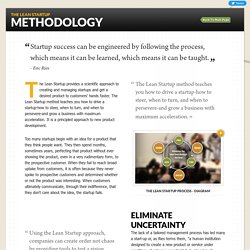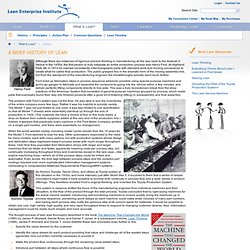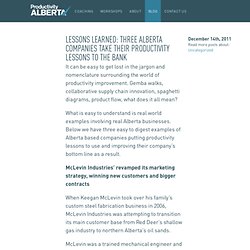

The Lean Startup. “Startup success can be engineered by following the process, which means it can be learned, which means it can be taught.”- Eric Ries The Lean Startup provides a scientific approach to creating and managing startups and get a desired product to customers' hands faster.

The Lean Startup method teaches you how to drive a startup-how to steer, when to turn, and when to persevere-and grow a business with maximum acceleration. It is a principled approach to new product development. Too many startups begin with an idea for a product that they think people want. They then spend months, sometimes years, perfecting that product without ever showing the product, even in a very rudimentary form, to the prospective customer.
The Lean Library. Lean.org. Knowledge Center. What is Lean. The core idea is to maximize customer value while minimizing waste.

Simply, lean means creating more value for customers with fewer resources. A lean organization understands customer value and focuses its key processes to continuously increase it. The ultimate goal is to provide perfect value to the customer through a perfect value creation process that has zero waste. To accomplish this, lean thinking changes the focus of management from optimizing separate technologies, assets, and vertical departments to optimizing the flow of products and services through entire value streams that flow horizontally across technologies, assets, and departments to customers.
Eliminating waste along entire value streams, instead of at isolated points, creates processes that need less human effort, less space, less capital, and less time to make products and services at far less costs and with much fewer defects, compared with traditional business systems. History. Although there are instances of rigorous process thinking in manufacturing all the way back to the Arsenal in Venice in the 1450s, the first person to truly integrate an entire production process was Henry Ford.

At Highland Park, MI, in 1913 he married consistently interchangeable parts with standard work and moving conveyance to create what he called flow production. The public grasped this in the dramatic form of the moving assembly line, but from the standpoint of the manufacturing engineer the breakthroughs actually went much further. Ford lined up fabrication steps in process sequence wherever possible using special-purpose machines and go/no-go gauges to fabricate and assemble the components going into the vehicle within a few minutes, and deliver perfectly fitting components directly to line-side.
The problem with Ford’s system was not the flow: He was able to turn the inventories of the entire company every few days. Rather it was his inability to provide variety. Action Plan. While every individual or company embarking on a lean journey will have different challenges based on their particular set of circumstances, there are several crucial steps that can help reduce resistance, spread the right learning, and engender the type of commitment necessary for lean enterprise.

Getting Started Find a change agent, a leader who will take personal responsibility for the lean transformation.Get the lean knowledge, via a sensei or consultant, who can teach lean techniques and how to implement them as part of a system, not as isolated programs.Find a lever by seizing a crisis or by creating one to begin the transformation. Creating an Organization to Channel Your Value Streams. Principles. Productivity Alberta: Articles: Lessons Learned: Three Alberta Companies Take Their Productivity Lessons to the Bank.
It can be easy to get lost in the jargon and nomenclature surrounding the world of productivity improvement.

Gemba walks, collaborative supply chain innovation, spaghetti diagrams, product flow, what does it all mean? What is easy to understand is real world examples involving real Alberta businesses. Below we have three easy to digest examples of Alberta based companies putting productivity lessons to use and improving their company’s bottom line as a result. McLevin Industries’ revamped its marketing strategy, winning new customers and bigger contracts When Keegan McLevin took over his family’s custom steel fabrication business in 2006, McLevin Industries was attempting to transition its main customer base from Red Deer’s shallow gas industry to northern Alberta’s oil sands. McLevin was a trained mechanical engineer and came from a long line of ironworkers and welders, but marketing wasn’t his area of expertise. “We’ve gone through so much change it’s hard to measure,” McLevin says. Lean Machines - Archives - ASSEMBLY. Acquiring capital equipment in a lean manufacturing environment requires a nontraditional mindset.

Imagine a board game for manufacturing engineers where all the game pieces are assembly machines, conveyors, parts feeders, robots and other types of equipment. The game takes place in a Tier 2 auto parts plant that has adopted lean production principles. The objective is to acquire the right type of assembly equipment while confronting management, operators and customers constantly chanting the lean manufacturing mantra of "waste elimination. " As lean initiatives become more popular, many engineers are playing that game every day. To thrive in that type of environment, engineers must break the age-old habit of always wanting to buy the fastest machine equipped with the latest bells and whistles.
Lean manufacturing has been touted as the panacea for the production world. However, it is often more difficult to justify capital equipment expenditure in a lean environment.